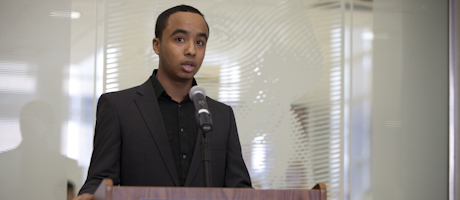By Jennifer Eder
Exactly one year after a 7.0 magnitude earthquake struck Haiti, members of the GW community gathered together to commemorate those who died and reflect on the ongoing reconstructive efforts.
“One year ago today Haiti was hit by a devastating earthquake that leveled cities and villages and took the lives of 300,000 people,” said Jason Lifton, Student Association president, during Wednesday’s ceremony. “While we literally did not feel the shake of the earthquake here at GW, the event still struck our community.”
President Steven Knapp said he knew GW’s response needed to be a multiyear response. And it’s proving to be just that.
Just 24 hours after the earthquake, three GW physicians and a graduate student traveled to Haiti as members of the Fairfax County Urban Search and Rescue team. GW students raised more than $9,000 for disaster relief and organized a candlelight vigil and letter writing event.
GW has also held two symposiums, both of which Haitian First Lady Elisabeth Delatour Preval, M.B.A. ’88, attended, on how to further the reconstruction of Haiti’s education and health systems. GW medical teams traveled to Haiti last summer to provide clinical care, and students and faculty from the Graduate School of Education and Human Development assessed the educational needs in Haiti during a visit in November.
“Coming together today is a reminder of how important it is for us to continue to pull together as a community,” said Dr. Knapp. “Your continued engagement is really critical to all of our efforts.”
Karl Delatour, the son of Mrs. Preval, spoke at the ceremony, which was held in the Marvin Center’s Great Hall.
Mr. Delatour, a freshman in the School of Business, was sitting at a table in his Port-au-Prince home eating rice and beans with his brother when the earthquake hit.
“It wasn’t until my glass of water fell to the ground and shattered that I realized that something big was happening. Something really big,” Mr. Delatour said. “I was sure it was the end of the world.”
When the earthquake stopped, Mr. Delatour ran to the house next door to look for his grandparents, but they had been crushed in the rubble.
Mr. Delatour said there is no easy road to recovery from the destruction left behind by the earthquake, which killed 300,000 people and left another 300,000 people handicapped or wounded. About 4,000 schools were destroyed, and 20 million cubic meters of rubble were left in the streets, of which only 10 percent has been cleared in the past year.
Mr. Delatour said he worries because Haiti has faded from the news, and he asked the GW community to continue to raise awareness about the recovery still needed.
“It’s not just about donating money,” he said. “It’s about moral support to the Haitian community.”
Lt. Paul Schurke, a naval engineer in the U.S. Coast Guard and a graduate student in the School of Engineering and Applied Science, spoke during the ceremony about being a first responder in Haiti. At the time he was serving at sea as an engineer officer onboard the USCGC Mohawk on a counter-narcotics mission just south of Haiti. Upon hearing about the earthquake, Lt. Schurke and the rest of the ship’s crew sailed to Haiti immediately, arriving 22 hours after the earthquake.
“What we found was an endless stream of wounded and thousands upon thousands of people in need of medical care, food, shelter and clean water,” said Lt. Schurke. “Our crew immediately compiled every supply on our ship. Every bottle and jug of water we could find, blankets, diapers, rice, beans and every single piece of medical equipment we could spare was sent ashore.”
Lt. Schurke said he was amazed to witness the courage and strength of the Haitian people despite such adversity.
“It is a disaster like this that reminds us that in this world there is no black and white. There is no Haitian, American or Sri. Lankan,” said Lt. Schurke. “There is only one identity that matters, and that is we are all members of one human family. And there’s a lesson to be learned from that.”


